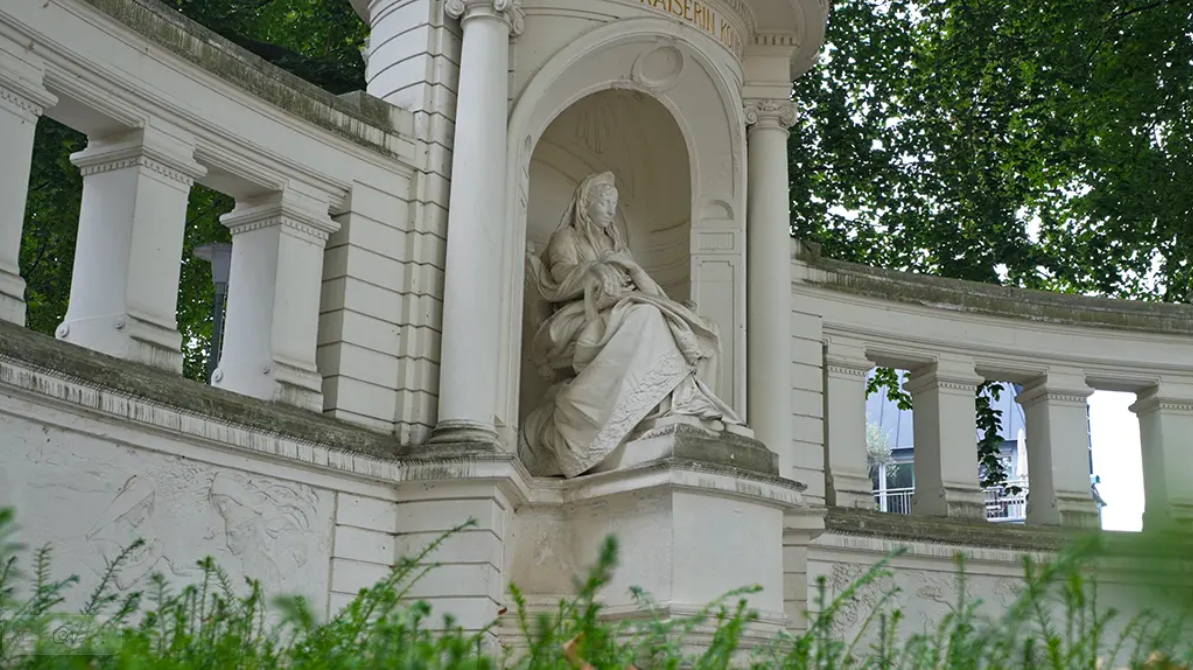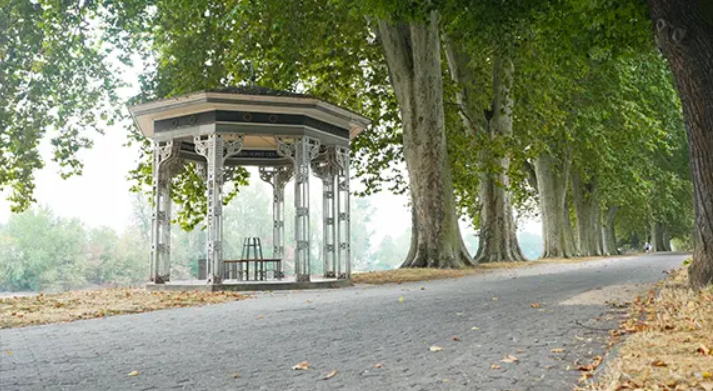An outstanding garden as part of the Rhine Gardens
Address: Kaiserin-Augusta-Anlagen, 56068 Koblenz | Built: 1856 to 1861 | Length: 2 km
On the left bank of the Rhine in Koblenz are the Konrad-Adenauer-Ufer and the Kaiserin-Augusta-Anlage, which merge together over a length of 3.5 kilometers. The southern section is the oldest, commissioned by Augusta of Saxe-Weimar-Eisenach, wife of Emperor Wilhelm I. The Kaiserin-Augusta-Anlage was designed by none other than the Prussian master gardener Peter-Joseph Lenné, who also designed the park of Sanssouci Palace and the Peacock Island, among other things. In 2011, for the Federal Garden Show, the Rhine Gardens were redesigned. The magnificent boulevard on the banks of the Rhine, which runs past important sights, invites you to take a stroll and offers many sights to admire.
Directions and location of the Koblenz landmark
The Empress Augusta Gardens in Koblenz, located on the left bank of the Rhine, run from north to south, forming a line through the southern suburbs and Koblenz’s old town. The Rhine Gardens are 3.5 kilometers long in total. The Deutsches Eck marks the end point. The Rhine Gardens extend approximately 1 kilometer south along the Konrad-Adenauer-Ufer to Stresemannstraße.
This is where the Empress Augusta Gardens begin. This area is the older, second section of the Rhine Gardens. The Empress Augusta Gardens run for approximately 2 kilometers to Mozartstraße. A bridge leads to the Oberwerth district. Near the Empress Augusta Monument is an old arm of the Rhine, the so-called Rheinlache (Rhine Pond). This separates the southern suburbs from Oberwerth.
The Rhine Gardens end at the railway embankment near Sebastian-Bach-Straße. The railway embankment belongs to the left bank of the Rhine and forms a branch that leads to the Hochheim railway bridge.
Opening Hours and Tours
The Kaiserin-Augusta Gardens are a public area in Koblenz and are accessible at any time to admire the numerous sights and enjoy the unique views.

Admission Fees
There are no admission fees for a visit to the Empress Augusta Gardens.
Guided Tours of the Empress Augusta Gardens
No guided tours are offered on-site at the Empress Augusta Gardens. However, there are occasionally special tours offered, such as the Tree Tour. During such tours, visitors are introduced to special specimens such as the bluebell tree, the handkerchief tree, the sweetgum, the Caucasian wingnut, and the giant sequoias found in the Empress Augusta Gardens. The botanical characteristics of each tree are highlighted, and myths and stories are told.
FAQ – Frequently Asked Questions about the Empress Augusta Gardens
What is the significance of the Empress Augusta Gardens?
The Empress Augusta Gardens are an important park in Koblenz, named after Augusta of Saxe-Weimar-Eisenach, the German Empress and wife of Emperor Wilhelm I. The gardens stretch along the banks of the Rhine and are known for their scenic beauty as well as their historical and cultural significance for the city. They offer locals and visitors a place to relax and are regularly the venue for events and festivals.
When were the Empress Augusta Gardens built?
The Empress Augusta Gardens were created in the 19th century between 1856 and 1861. They were designed as part of the urban expansion of Koblenz according to plans by the Prussian gardening director Peter Joseph Lenné.
How long are the Empress Augusta Gardens?
The Empress Augusta Gardens extend over a length of about 1.5 kilometers along the banks of the Rhine in Koblenz.
Empress Augusta Park – Special Features and Interesting Facts
On the left bank of the Rhine in Koblenz are the Empress Augusta Parks, which merge into the Konrad Adenauer Ufer and extend over a total length of 3.5 kilometers. Together, the two parks are known as the Rheinanlage, with the Empress Augusta Park being the oldest part.
Augusta of Saxe-Weimar-Eisenach, wife of Emperor Wilhelm I, commissioned the park between 1856 and 1861. None other than Peter Josef Lenné was commissioned to design the Empress Augusta Park. He enjoyed a high reputation as a master gardener at the Prussian court. Lené designed the park on the banks of the Rhine according to plans by Herman Prince von Pückler-Muskau.
Over their approximately 200-year history, the appearance of the Rheinanlagen and also the Empress Augusta Parks have changed repeatedly. The first Rhine parks date back to the French period. Prefect Adrien de Lezay-Marnésia had the first park and botanical garden open to the public built on the banks of the Rhine.
Empress Augusta had a new park laid out, featuring sculptures, terraces, fountains, and pavilions. The park was intended to be a meeting place for citizens to relax and learn. At the same time, the park was intended to symbolize social harmony and underscore the ties to the Prussian royal family.
Changes were made after World War II. Garden Director Wilhelm Mutzbauer redesigned the Empress Augusta Gardens with sparse trees, wide lawns, and asymmetrical shapes. The new, open and light character of the Rhine Gardens reflected the spirit of the 1950s. However, the actual presentation of the gardens remained essentially true to the design principle.
The old leitmotif was also taken up during the renovation and redesign for the Federal Garden Show, and parts of it were revived. The grand staircase on the Rhine bank in front of the palace is a striking example of this.
Strolling through the Empress Augusta Gardens not only offers fantastic views, but also discovers unique features such as enchanting pavilions, impressive sculptures, and imaginative fountains. Nature seems to be in harmony with the river Rhine, flowing leisurely along its riverbed.

Historical Facts and History of the Empress Augusta Park
The Empress Augusta Park was originally located on the banks of the Rhine, and was expanded in 1900 to include the Konrad-Adenauer-Ufer and reach the Deutsches Eck. Despite destruction during World War II and numerous redesigns, the charm of the parks between the Pfaffendorfer Bücke and the Rheinlache has been preserved in a special way.
In the mid-19th century, the fortress city of Koblenz was unable to expand beyond the fortifications, partly because development outside the city walls was prohibited. Within the city walls, development became increasingly dense, leaving little space for recreation. Empress Augusta’s basic idea in creating a place for the citizens of Koblenz to relax and unwind was the basic idea behind the creation of the park on the banks of the Rhine.
As early as the late 18th century, the citizens of Koblenz used strolling as a special leisure activity. A path was laid out along the Rhine bank with side paths, extending from the Rhine Connection Barracks to the Pfaffendorf Bridge. Groups of trees were planted in the park, and an avenue of plane trees was created.
There was a drinking hall, numerous viewing and resting places, and a cold-water sanatorium. Even then, one could observe the busy boat traffic on the Rhine while strolling. Then as now, the Empress Augusta Gardens are lined with villas built in 1890.
During the reconstruction after World War II, the Empress Augusta Gardens were redesigned to create more open space. The drinking hall also disappeared during this time, replaced by a bandstand. Unfortunately, very little of the old inventory remains. The Empress Augusta Monument, inaugurated in 1896, is particularly striking. The people of Koblenz wanted to remember the Empress, who, even in her old age, still enjoyed spending time in Koblenz. The Empress Augusta Monument was designed by Bruno Schmitz, and the statue was created by the sculptor Moest. The monument, which stands on Princess Luise’s playground, is said to have been the starting point for the planning of the park.
The Empress Augusta Gardens were redesigned again for the Federal Garden Show in 2011. Today, the park landscape on the banks of the Rhine is considered a true gem. A magnificent Rhine Boulevard has been created, exuding a special charm.

Sights and attractions in the immediate vicinity of the Empress Augusta Park
You don’t have to walk far to discover interesting sights and attractions, as the Empress Augusta Park has some special treasures to offer.
A little further down the Rhine is the Luisentempel (also called the Salvetempel), at the edge of the Plane Tree Avenue. This was donated to Empress Augusta by Luise and her brother Friedrich.
If you continue walking through the Empress Augusta Park with your eyes open, you will discover the Kaiserhalle (Imperial Hall) in the arch of the Pfaffendorfer Bridge. It is a reminder of the 25-year-long connection between Emperor Wilhelm I, his wife Empress Augusta, and Koblenz.
At the beginning of the Empress Augusta Park, near the Kaiserhalle and the wine village, there is an interesting monument depicting the poet Max von Schenkendorf. He was very popular in the 19th century due to his patriotic stories. The monument has stood in the park since 1861.
The Coblenz Bridge Monument is located nearby.
If you continue walking, you’ll discover the Wine Fountain, also known as the Grape Carrier Fountain, a little further away. It was created in 1928 and originally stood in front of the Rheinhalle until it was moved to its current location.
Cafés and Restaurants Near the Kaiserin-Augusta-Anlage
After a long stroll along the Rhine riverbank, through the Kaiserin-Augusta-Anlage to the Konrad-Adenauer-Ufer, numerous restaurants offer their guests a wonderful selection of food and drinks, served in a cozy atmosphere. When the weather is nice, the outdoor terraces are also open for guests to fully enjoy the lively hustle and bustle and the unique view.
The Restaurant Lieblingsplatz im Kleiner Riesen is located directly next to the Kaiserin-Augusta-Anlage. The menu features delicious starters, a lovely selection of main courses, seasonal dishes with fresh vegetables, and delicious desserts. Drinks also offer a wide variety, from delicious aperitifs to various wines, cold beer, and non-alcoholic beverages.
Address: Restaurant Lieblingsplatz im Kleiner Riesen, Kaiserin-Augusta-Anlagen 18
Weindorf Koblenz
The wine village of Koblenz, located on Julius-Wegeler-Straße, is very close to the Kaiserin-Augusta Gardens and is definitely worth a visit. Charming half-timbered houses house various wine restaurants where guests can enjoy everything from rustic to fine German cuisine or a hearty Sunday brunch. There is also a fantastic and extensive selection of regional wines.
Address: Weindorf Koblenz, Julius-Wegeler-Straße 2
Restaurant Croatia is located on Hohenzollernstraße. Selected Croatian delicacies are freshly prepared for guests. The menu includes delicious fish and tasty meats with special side dishes, as well as regional dishes. For those with a light appetite, delicious salads or fresh pancakes are available. The drinks menu includes not only wine, beer, and non-alcoholic beverages, but also delicious tea.
Address: Restaurant Croatia, Hohenzollernstraße 116
Restaurant Pegelhaus
Walking through the Kaiserin-Augusta-Anlage, past the palace to the Konrad-Adenauer-Ufer, you can’t miss the Pegelhaus on the Konrad-Adenauer-Ufer. The restaurant is located in a historic 19th-century building, directly on the banks of the Rhine. In a casual atmosphere with a great view, guests are treated to burgers, steaks, exclusive side dishes, and delicious salad creations.
Address: Restaurant Pegelhaus, Konrad-Adenauer-Ufer 1
The Verbene Bistro at Rheinstraße 2A spoils its guests with lovingly prepared regional, German, and European dishes. The menu includes not only small plates, but also multi-course menus. Vegetarians are also well catered for. Gourmets and lovers of fine dining will find their fill at the Verbene Bistro.
Address: Verbene Bistro, Rheinstraße 2A